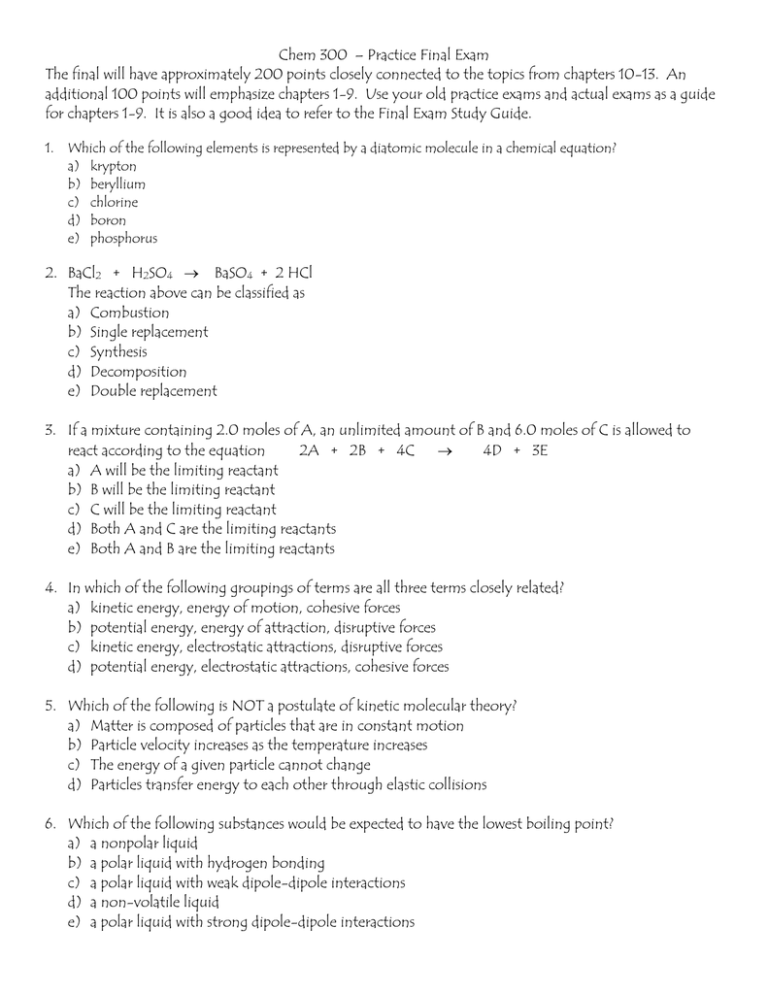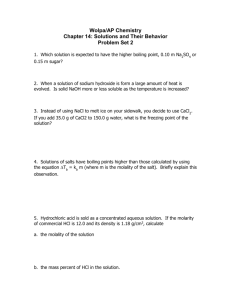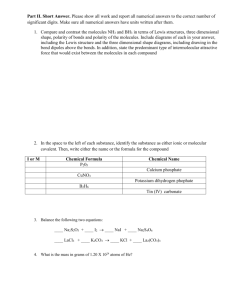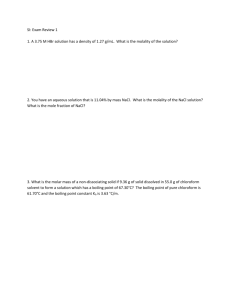Chem 300 – Practice Final Exam
advertisement

Chem 300 – Practice Final Exam The final will have approximately 200 points closely connected to the topics from chapters 10-13. An additional 100 points will emphasize chapters 1-9. Use your old practice exams and actual exams as a guide for chapters 1-9. It is also a good idea to refer to the Final Exam Study Guide. 1. Which of the following elements is represented by a diatomic molecule in a chemical equation? a) krypton b) beryllium c) chlorine d) boron e) phosphorus 2. BaCl2 + H2SO4 BaSO4 + 2 HCl The reaction above can be classified as a) Combustion b) Single replacement c) Synthesis d) Decomposition e) Double replacement 3. If a mixture containing 2.0 moles of A, an unlimited amount of B and 6.0 moles of C is allowed to react according to the equation 2A + 2B + 4C 4D + 3E a) A will be the limiting reactant b) B will be the limiting reactant c) C will be the limiting reactant d) Both A and C are the limiting reactants e) Both A and B are the limiting reactants 4. In which of the following groupings of terms are all three terms closely related? a) kinetic energy, energy of motion, cohesive forces b) potential energy, energy of attraction, disruptive forces c) kinetic energy, electrostatic attractions, disruptive forces d) potential energy, electrostatic attractions, cohesive forces 5. Which of the following is NOT a postulate of kinetic molecular theory? a) Matter is composed of particles that are in constant motion b) Particle velocity increases as the temperature increases c) The energy of a given particle cannot change d) Particles transfer energy to each other through elastic collisions 6. Which of the following substances would be expected to have the lowest boiling point? a) a nonpolar liquid b) a polar liquid with hydrogen bonding c) a polar liquid with weak dipole-dipole interactions d) a non-volatile liquid e) a polar liquid with strong dipole-dipole interactions 7. Which of the following molecules are capable of hydrogen bonding with water? H2S NH3 H2 HBr CH4 HF a) NH3 H2 HBr b) NH3 HF c) H2S CH4 d) H2S H2 HBr e) CH4 HF 8. The normal boiling point of a substance is determined by its molecular mass and its intermolecular forces. Considering these two factors, predict the order of INCREASING boiling points for the following substances: H2 NH3 H2S N2 a) N2 < H2 < NH3 < H2 S b) H2 < N2 < H2 S < NH3 c) H2 S < NH3 < N2 < H2 d) H2 < NH3 < H2 S < N2 e) NH3 < H2 S < N2 < H2 9. In a solution, the solute is a) always water b) always a liquid c) the substance present in the greatest amount d) the substance being dissolved e) never a gas 10. Which type of compound is NOT likely to dissolve in water? a) one with hydrogen bonds b) a nonpolar compound c) a salt d) a highly polar compound e) a compound that the predominate intermolecular forces are dipole-dipole interactions 11. Silver metal can be recovered from an ore containing Ag2CO3 by the following reaction. 2 Ag2CO3 4 Ag + 2 CO2 + O2 What mass of silver ore, in tons, is needed to produce 125 lb of Ag if the ore is 24.7% by mass Ag2CO3? 12. Classify and Balance the following equations. a. C4H10 + O2 CO2 + H2O b. BaO2 c. Au2S3 + d. P + BaO + H2 I2 O2 H2S + Au PI3 13. Answer the following questions using the chemical equation below: 3 CaCl2(aq) + 2 H3PO4(aq) Ca3(PO4)2(s) + 6 HCl(aq) a. How many moles of H3PO4 react with 3.75 moles CaCl2? b. How many calcium atoms are produced from a reaction using 42.5 mg moles H3PO4? c. How many grams of CaCl2 are needed to prepare 250. mL of a 1.50 M CaCl2 solution? d. How many mL of a 1.50 M CaCl2 solution are needed to prepare 500. mL of a 0.250 M CaCl2 solution? e. How many grams of Ca3(PO4)2 can be produced when 500. mL of 0.250 M CaCl2 reacts with excess 0.500M H3PO4? f. If you recover 10.2 grams of Ca3(PO4)2 from reaction (e) above, what is the percent yield? 14. Predict the order of increasing boiling points for the following substances. H2, NaCl, H2O, CO2 (list from lowest bp to highest bp) 15 Predict whether the following solutes are VERY SOLUBLE or SLIGHTLY SOLUBLE in water. F2 ____________________ CO2 ____________________ PH3 ____________________ HCl ____________________ 16.Complete the table below AND arrange the 3 cpds in order of increasing boiling point. Molecular Molecular Dominant Compound Lewis structure Geometry Polarity Intermolecular force NH3 CH4 SO2 17. A sample of ammonia gas (NH3) in a 375mL container at a pressure of 1.03atm and a temperature of 27C is transferred to a container with a volume of 1.25L. What is the new pressure, in mmHg, if the temperature increases to 35C? 18. Calculate the volume (in liters) of 1.15 moles of F2 gas at STP. 19. A 6.01 g sample of a gaseous compound containing only carbon and hydrogen contains 4.80 g of carbon and 01.21 g of hydrogen. At STP, 762 mL of the gas have a mass of 1.02 g. What is the molecular formula for the compound?






